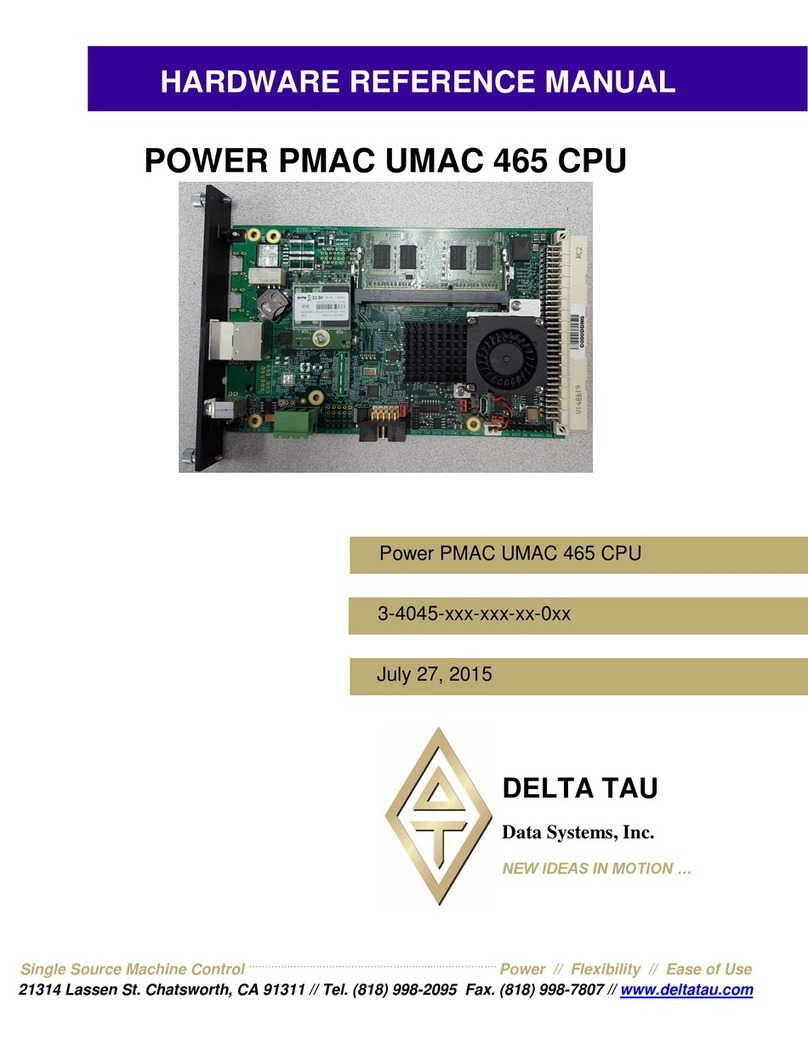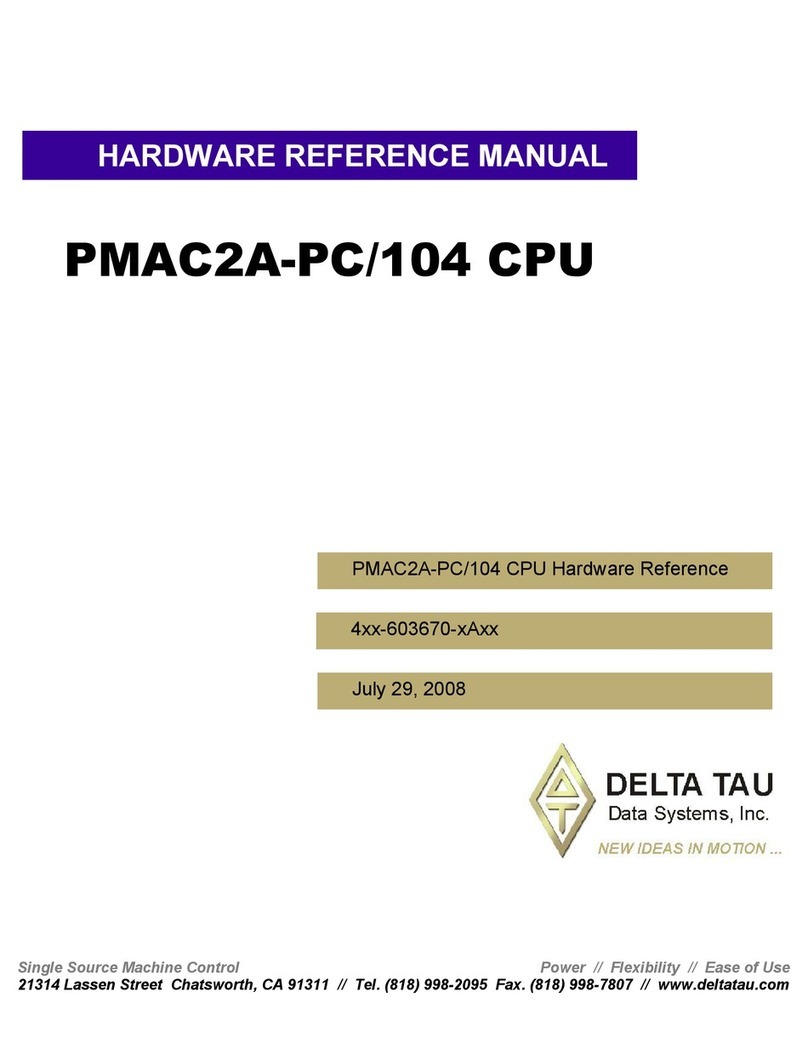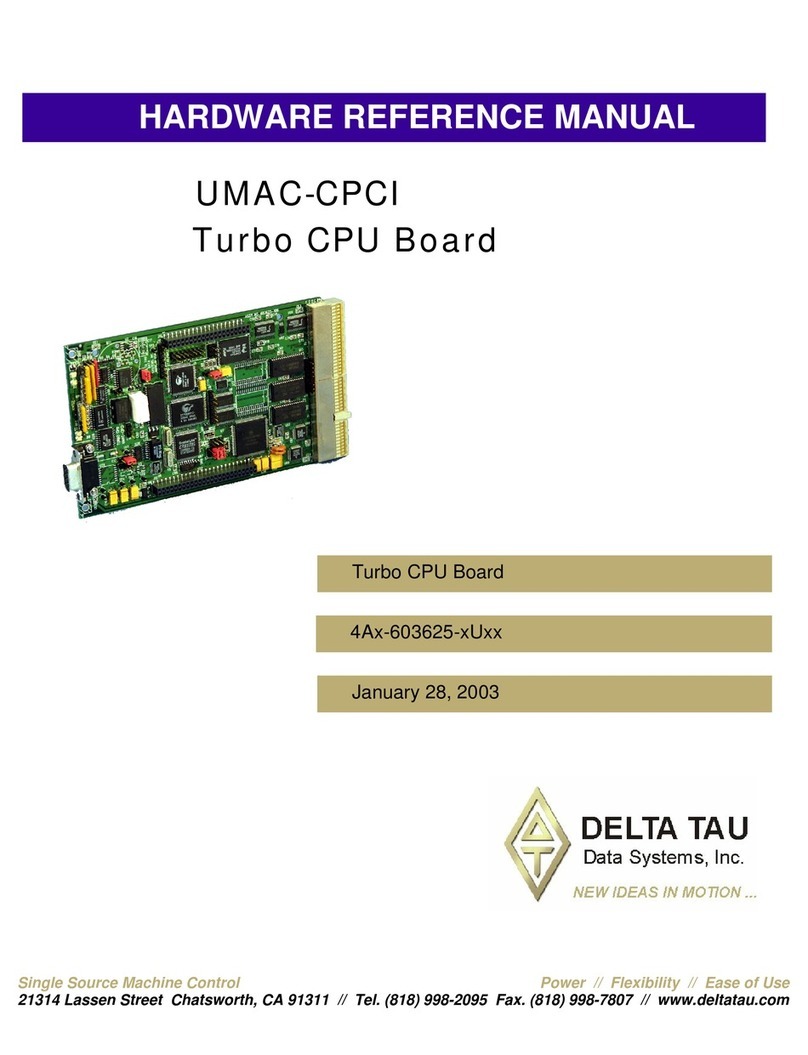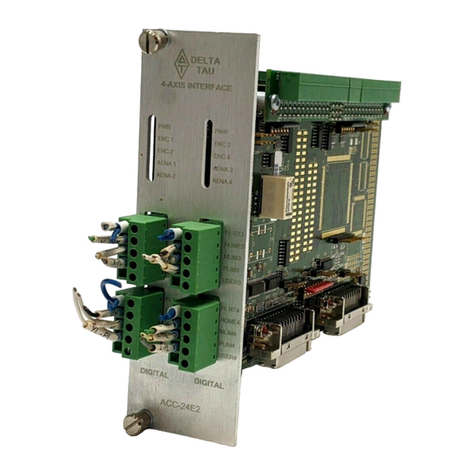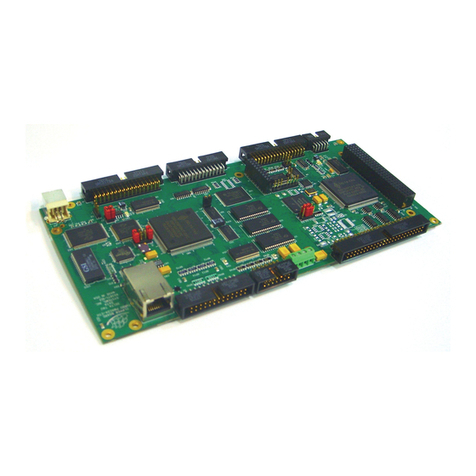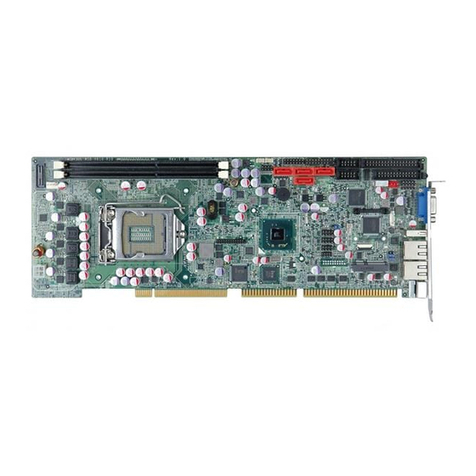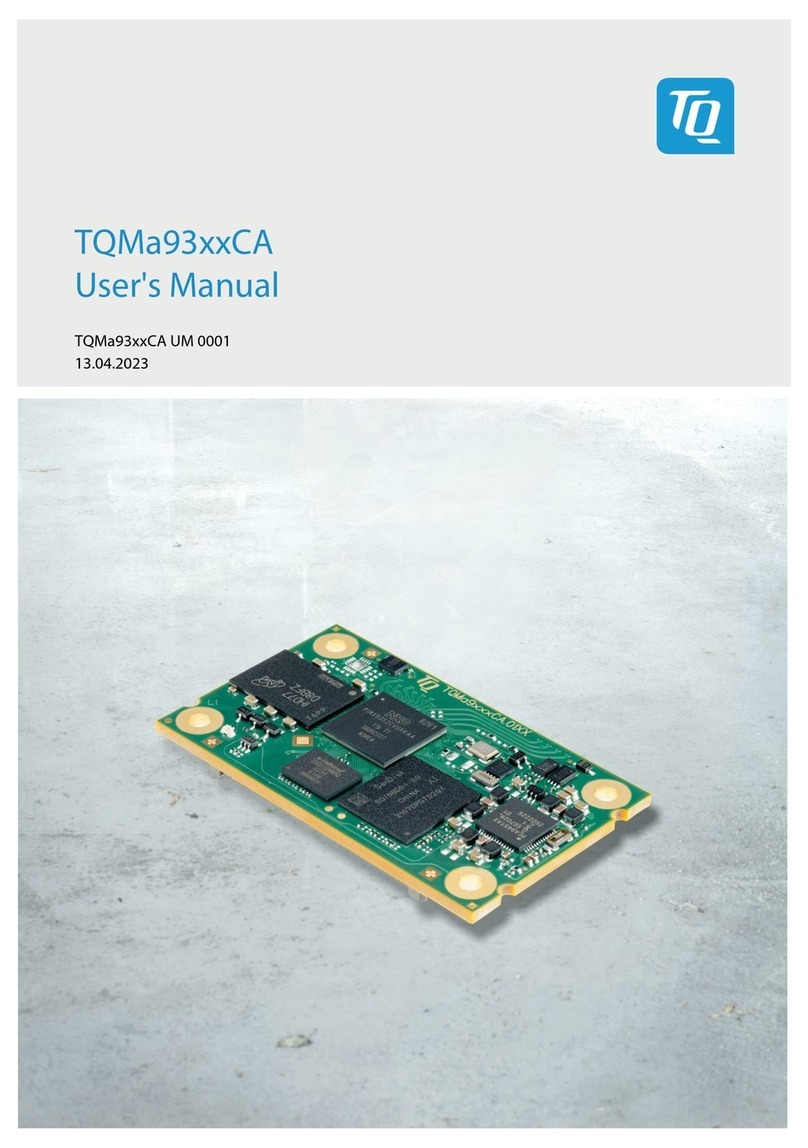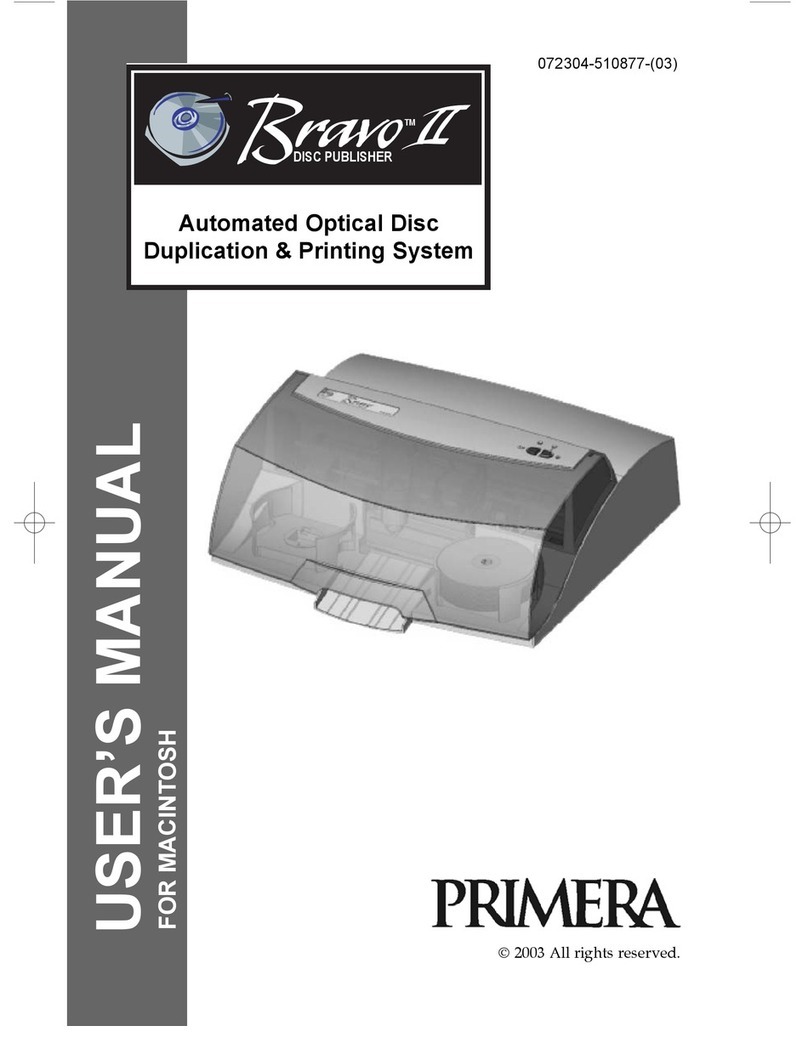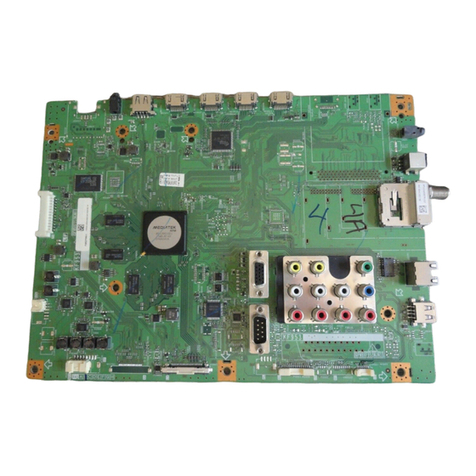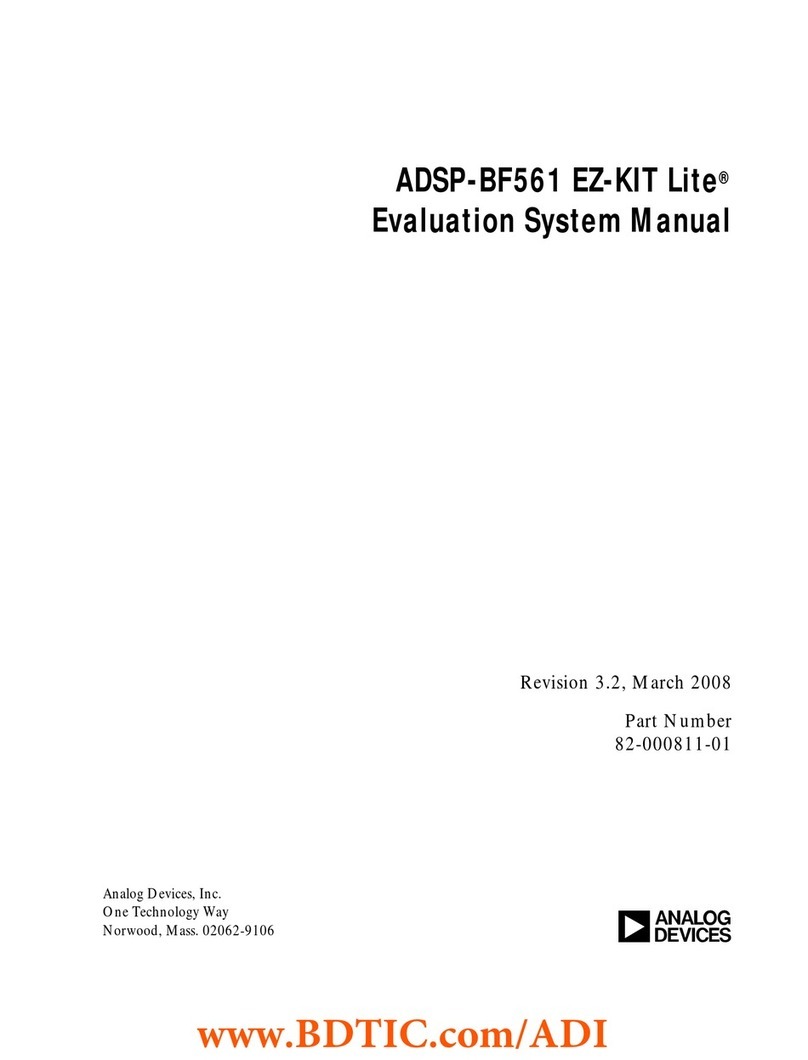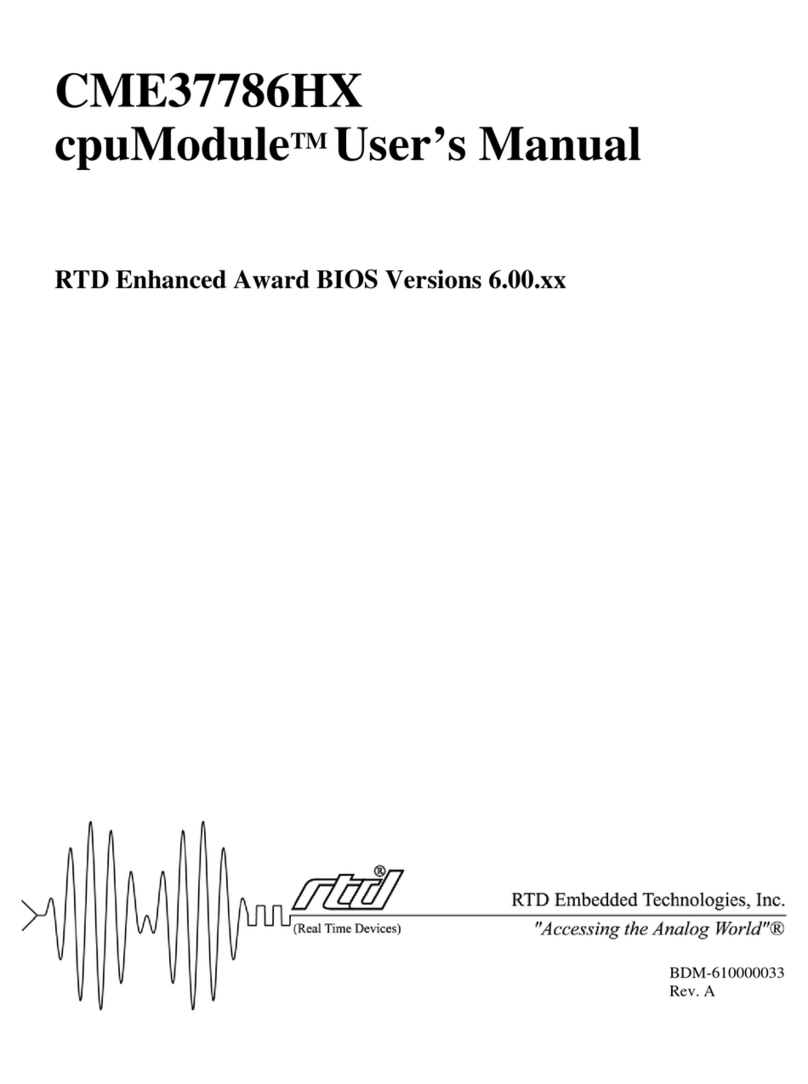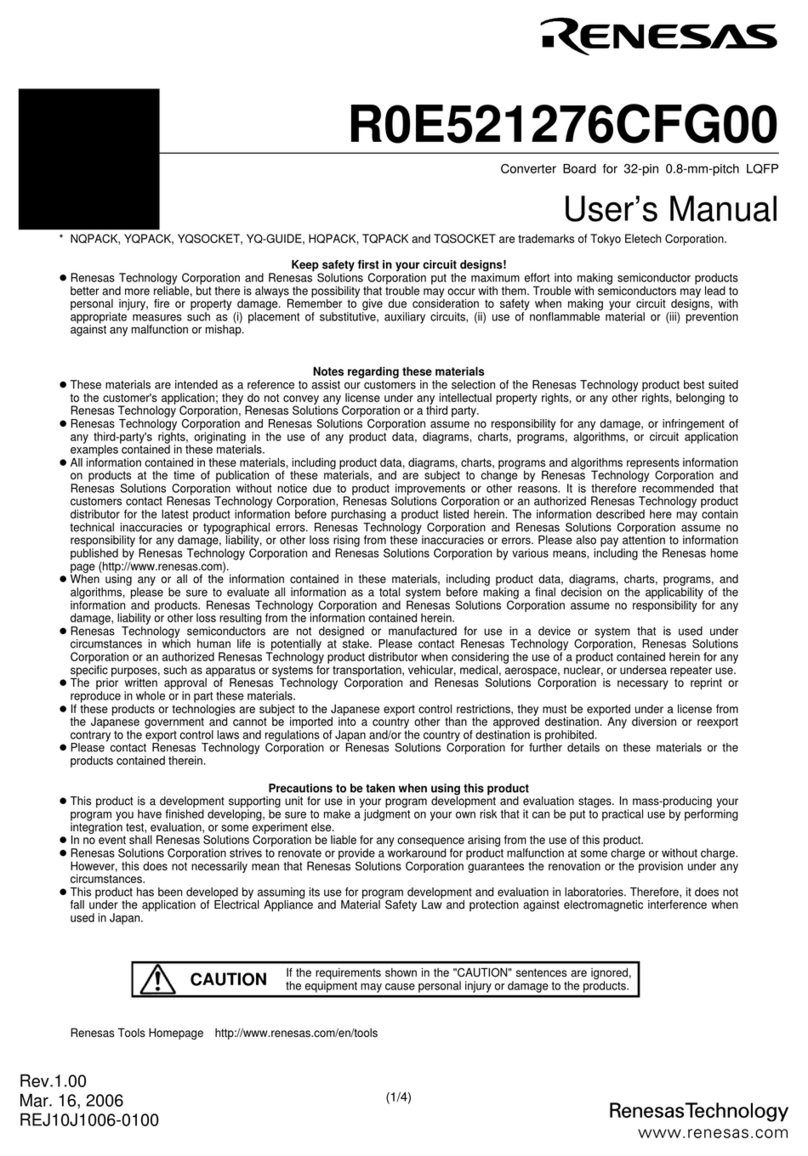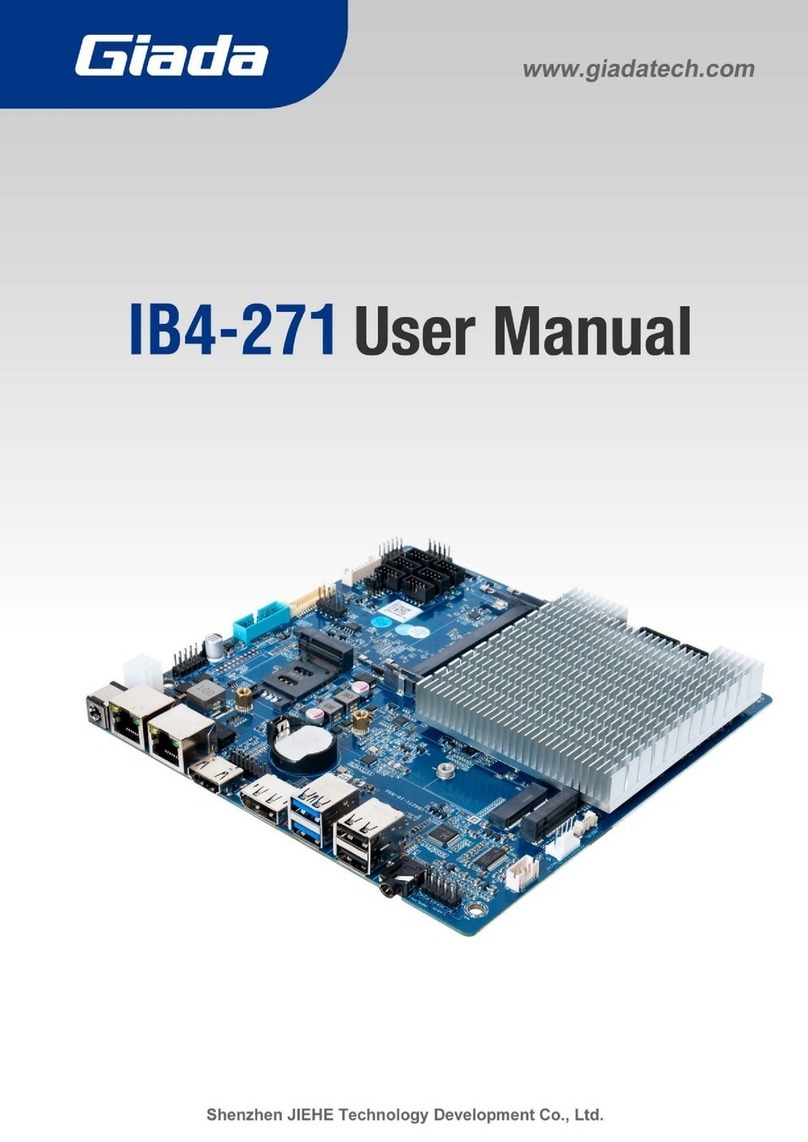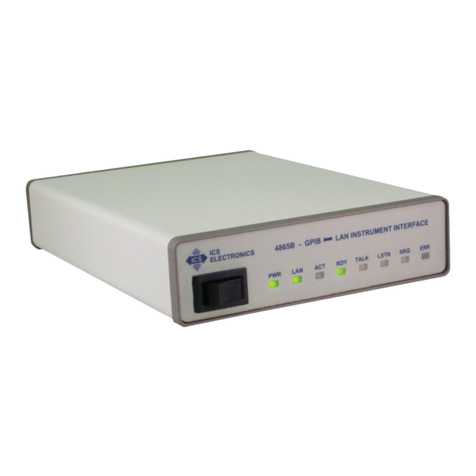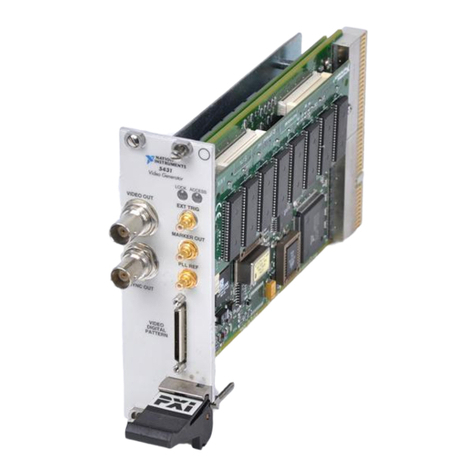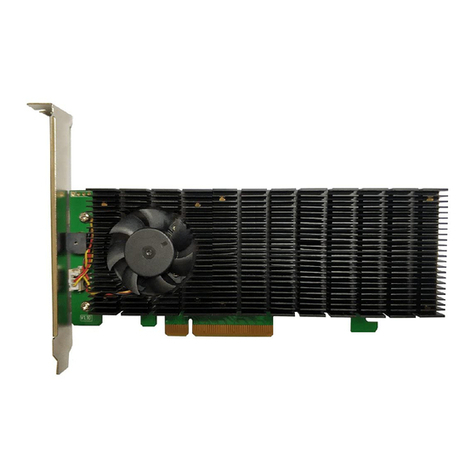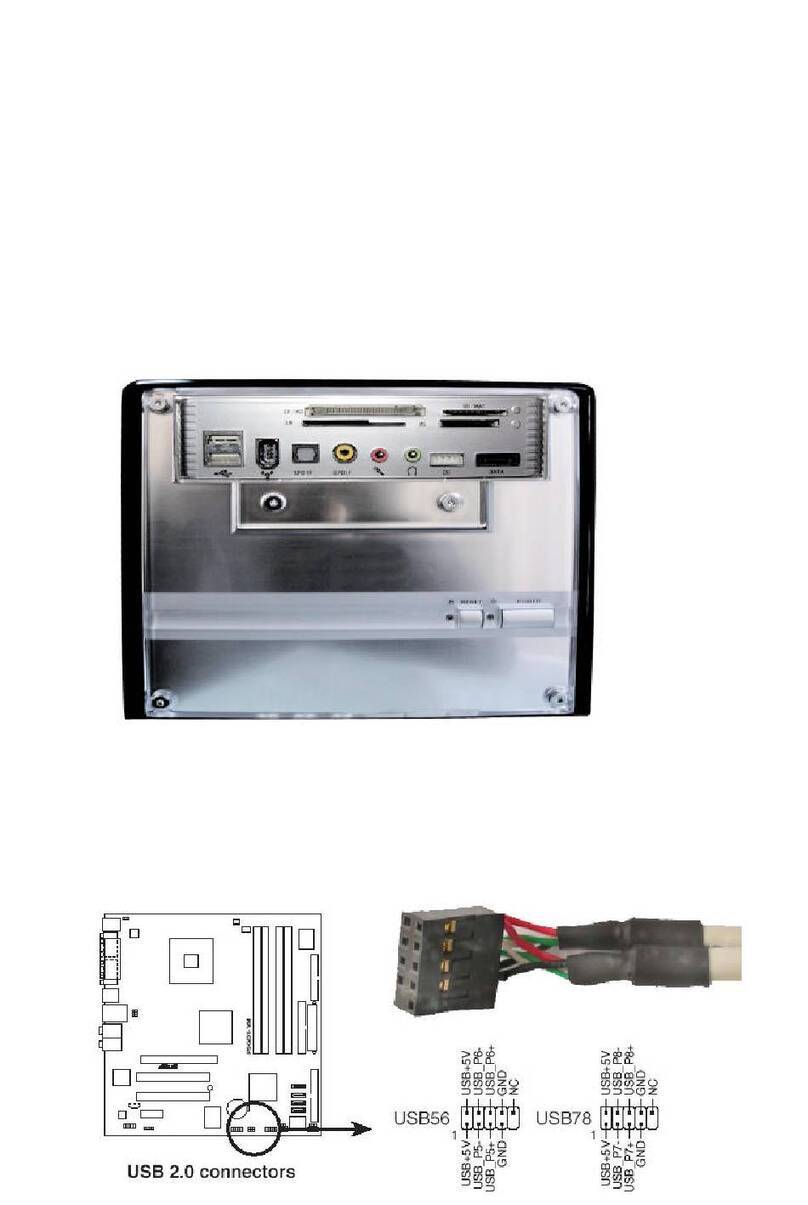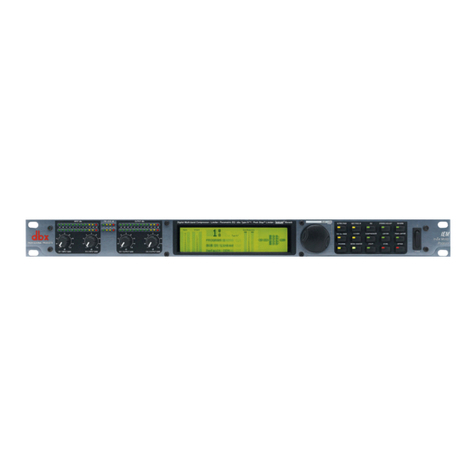Delta Tau PMAC2A-PC/104 User manual

^3 Compact Version of PMAC Family
^4 4xx-603670-xHxx
^5 January 29, 2003
^1 HARDWARE REFERENCE MANUAL
^2 PMAC2
A
-PC/104
INSTALLATION MANUAL
Single Source Machine Control Power // Flexibility // Ease of Use
21314 Lassen Street Chatsworth, CA 91311 // Tel. (818) 998-2095 Fax. (818) 998-7807 // www.deltatau.com


PMAC2A-PC/104
Table of Contents i
TABLE OF CONTENTS
INTRODUCTION.......................................................................................................................................................1
OVERVIEW .................................................................................................................................................................1
BOARD CONFIGURATION............................................................................................................................................1
Base Version.........................................................................................................................................................1
Option 2A: PC/104 bus stack interface.................................................................................................................1
Option 5xF: CPU Speed Options..........................................................................................................................1
Option 6: Extended Firmware Algorithm.............................................................................................................2
Option 6L: Multi-block lookahead firmware........................................................................................................2
Option 10: Firmware Version Specification.........................................................................................................2
Option 12: Analog-to-Digital Converters.............................................................................................................2
ACC-1P: Axis expansion piggyback board...........................................................................................................2
ACC-1P Option 1: I/O ports.................................................................................................................................2
ACC-1P Option 2: Analog-to-Digital Converters ................................................................................................2
ACC-2P: Communications Board.........................................................................................................................3
ACC-2P Option 1A: USB Interface ......................................................................................................................3
ACC-2P Option 1B: Ethernet Interface................................................................................................................3
ACC-2P Option 2: DPRAM circuitry ...................................................................................................................3
ACC-2P Option 3: I/O ports.................................................................................................................................4
ACC-8TS connections board.................................................................................................................................4
ACC-8ES Four channel dual-DAC analog stack board .......................................................................................4
ACC-8FS Four channel direct PWM stack breakout board.................................................................................4
BASE BOARD HARDWARE SETUP ......................................................................................................................5
CLOCK CONFIGURATION JUMPERS..............................................................................................................................5
BOARD RESET JUMPERS.............................................................................................................................................5
CPU JUMPER CONFIGURATION..................................................................................................................................6
COMMUNICATION JUMPERS .......................................................................................................................................6
I/O CONFIGURATION JUMPERS...................................................................................................................................6
RESISTOR PACKS CONFIGURATION ............................................................................................................................6
Differential or Single-Ended Encoder selection ...................................................................................................6
ACC-1P HARDWARE SETUP..................................................................................................................................9
I/O CONFIGURATION JUMPERS...................................................................................................................................9
RESERVED CONFIGURATION JUMPERS .......................................................................................................................9
RESISTOR PACKS CONFIGURATION ............................................................................................................................9
Differential or Single-Ended Encoder selection ...................................................................................................9
Handwheel Encoder Termination Resistors........................................................................................................10
ACC-2P HARDWARE SETUP................................................................................................................................11
I/O CONFIGURATION JUMPERS.................................................................................................................................11
COMMUNICATION JUMPERS .....................................................................................................................................11
RESISTOR PACKS CONFIGURATION ..........................................................................................................................11
Differential or Single-Ended Handwheel Encoder selection..............................................................................11
Handwheel Encoder Termination Resistors........................................................................................................12
MACHINE CONNECTIONS...................................................................................................................................13
MOUNTING...............................................................................................................................................................13
POWER SUPPLIES .....................................................................................................................................................13
Digital Power Supply..........................................................................................................................................13
DAC Outputs Power Supply................................................................................................................................14
Flags Power Supply............................................................................................................................................14
OVER-TRAVEL LIMITS AND HOME SWITCHES...........................................................................................................14
Types of overtravel limits....................................................................................................................................14

PMAC2A-PC/104
Table of Contents
ii
Home switches ....................................................................................................................................................14
MOTOR SIGNALS CONNECTIONS...............................................................................................................................15
Incremental Encoder Connection .......................................................................................................................15
DAC Output signals............................................................................................................................................15
Pulse and Direction (Stepper) Drivers ...............................................................................................................16
Amplifier Enable Signal (AENAx/DIRn).............................................................................................................16
Amplifier Fault Signal (FAULT-) .......................................................................................................................16
ACC-1P GENERAL-PURPOSE DIGITAL INPUTS AND OUTPUTS (J7 PORT).................................................................16
ACC-2P GENERAL-PURPOSE DIGITAL INPUTS AND OUTPUTS (JOPT PORT)...........................................................17
ACC-1P THUMBWHEEL MULTIPLEXER PORT (J2 PORT) .........................................................................................17
ACC-2P THUMBWHEEL MULTIPLEXER PORT (JTHW PORT) ..................................................................................18
ACC-1P OR ACC-2P HANDWHEEL PORT (JHW / PD PORT)...................................................................................18
OPTIONAL ANALOG INPUTS .....................................................................................................................................18
COMPARE EQUAL OUTPUTS.....................................................................................................................................18
SERIAL PORT (JRS232 PORT) ..................................................................................................................................19
ACC-2P ETHERNET RJ45 CONNECTOR (J10 PORT).................................................................................................19
ACC-2P USB CONNECTOR (J1 PORT).....................................................................................................................19
MACHINE CONNECTIONS EXAMPLE: USING ANALOG ±10 VOLTS AMPLIFIER.........................................................20
MACHINE CONNECTIONS EXAMPLE: USING PULSE AND DIRECTION DRIVERS...........................................................21
PMAC2A-PC/104 SOFTWARE SETUP.................................................................................................................22
COMMUNICATIONS...................................................................................................................................................22
PMAC I-VARIABLES ...............................................................................................................................................22
OPERATIONAL FREQUENCY AND BAUD RATE SETUP ...............................................................................................22
DAC OUTPUTS CONFIGURATION.............................................................................................................................23
USING FLAG I/O AS GENERAL-PURPOSE I/O............................................................................................................24
GENERAL-PURPOSE DIGITAL INPUTS AND OUTPUTS................................................................................................24
ACC-1P with jumper E6 on position 1-2 ............................................................................................................24
ACC-2P with jumper E5 in position 2-3.............................................................................................................25
THUMBWHEEL PORT DIGITAL INPUTS AND OUTPUTS ..............................................................................................26
ACC-1P with jumper E6 in position 1-2.............................................................................................................26
ACC-2P with jumper E5 in position 2-3.............................................................................................................26
ANALOG INPUTS SETUP............................................................................................................................................27
Base Board Analog Inputs..................................................................................................................................27
ACC-1P Analog Inputs .......................................................................................................................................27
BASE BOARD HARDWARE REFERENCE SUMMARY...................................................................................29
BOARD DIMENSIONS................................................................................................................................................29
BOARD LAYOUT.......................................................................................................................................................29
CONNECTORS AND INDICATORS...............................................................................................................................30
J3 - Machine Connector (JMACH1 Port)...........................................................................................................30
J4 - Machine Connector (JMACH2 Port)...........................................................................................................30
J8 - Serial Port (JRS232 Port)............................................................................................................................30
TB1 – Power Supply Terminal Block (JPWR Connector)...................................................................................31
LED Indicators ...................................................................................................................................................31
ACC-1P HARDWARE REFERENCE SUMMARY..............................................................................................32
BOARD DIMENSIONS................................................................................................................................................32
BOARD LAYOUT.......................................................................................................................................................32
CONNECTORS AND INDICATORS...............................................................................................................................33
J2 - Thumbwheel Multiplexer Port (JTHW Port)................................................................................................33
J3 - Machine Connector (JMACH1 Port)...........................................................................................................33
J4 - Machine Connector (JMACH2 Port)...........................................................................................................34
J7 - General-Purpose Digital Inputs and Outputs (JOPT Port).........................................................................34
J8 – Handwheel / Pulse and Direction Port (JHW / PD Port) ...........................................................................34
TB1 – Power Supply Terminal Block (JPWR Connector)...................................................................................34

PMAC2A-PC/104
Table of Contents iii
LED Indicators ...................................................................................................................................................34
ACC-2P HARDWARE REFERENCE SUMMARY..............................................................................................36
BOARD DIMENSIONS................................................................................................................................................36
BOARD LAYOUT.......................................................................................................................................................36
CONNECTORS AND INDICATORS ...............................................................................................................................37
J1 – USB Communications Port .........................................................................................................................37
J2 - Thumbwheel Multiplexer Port (JTHW Port)................................................................................................37
J7 - General-Purpose Digital Inputs and Outputs (JOPT Port).........................................................................37
J8 – Handwheel / Pulse and Direction Port (JHW / PD Port) ...........................................................................38
J10 – Ethernet Communications Port.................................................................................................................38
TB1 – Power Supply Terminal Block (JPWR Connector)...................................................................................39
LED Indicators ...................................................................................................................................................39
BASE BOARD E-POINT JUMPER DESCRIPTIONS .........................................................................................40
E0: FORCED RESET CONTROL..................................................................................................................................40
E1: SERVO AND PHASE CLOCK DIRECTION CONTROL..............................................................................................40
E2: CPU FREQUENCY SELECT .................................................................................................................................41
E3: NORMAL/RE-INITIALIZING POWER-UP/RESET ...................................................................................................41
E4: CPU FREQUENCY SELECT .................................................................................................................................41
E8: PHASE CLOCK LINES OUTPUT ENABLE..............................................................................................................42
E9: SERVO CLOCK LINES OUTPUT ENABLE .............................................................................................................42
E10 – E12: POWER-UP STATE JUMPERS..................................................................................................................42
E13: POWER-UP/RESET LOAD SOURCE ...................................................................................................................43
E14: WATCHDOG DISABLE JUMPER.........................................................................................................................43
E15A, B, C: FLASH MEMORY BANK SELECT...........................................................................................................43
E16: ADC INPUTS ENABLE......................................................................................................................................44
E18 – E19: PC/104 BUS ADDRESS ..........................................................................................................................44
ACC-1P E-POINT JUMPER DESCRIPTIONS.....................................................................................................46
E0: RESERVED FOR FUTURE USE .............................................................................................................................46
E1 - E2: MACHINE OUTPUT SUPPLY VOLTAGE CONFIGURE ....................................................................................46
E3 – E4: JHW, PD FUNCTION SELECT ....................................................................................................................47
E5: SERVO GATE ADDRESS SELECT.........................................................................................................................47
E6: I/O GATE ADDRESS SELECT ..............................................................................................................................47
E7: MACHINE INPUT SOURCE/SINK CONTROL.........................................................................................................47
E16: ADC INPUTS ENABLE......................................................................................................................................48
ACC-2P E-POINT JUMPER DESCRIPTIONS.....................................................................................................50
E3 – E4: JHW, PD FUNCTION SELECT ....................................................................................................................50
E5: I/O GATE ADDRESS SELECT ..............................................................................................................................50
E6: COMMUNICATIONS PORT SELECT ......................................................................................................................50
E7- E10: PORTS DIRECTION CONTROL ....................................................................................................................50
BASE BOARD CONNECTOR PINOUTS..............................................................................................................52
TB1 (JPWR): POWER SUPPLY.................................................................................................................................52
J4 (JRS232) SERIAL PORT CONNECTOR ..................................................................................................................52
J3 (JMACH1): MACHINE PORT CONNECTOR ..........................................................................................................53
J4 (JMACH2): MACHINE PORT CONNECTOR ..........................................................................................................54
ACC-1P CONNECTOR PINOUTS.........................................................................................................................56
TB1 (JPWR): POWER SUPPLY.................................................................................................................................56
J2 (JTHW): MULTIPLEXER PORT CONNECTOR........................................................................................................56
J3 (JMACH1): MACHINE PORT CONNECTOR ..........................................................................................................57
J4 (JMACH2): MACHINE PORT CONNECTOR ..........................................................................................................59
J7 (JOPTO): I/O PORT CONNECTOR........................................................................................................................60

PMAC2A-PC/104
Table of Contents
iv
J8 (JHW) HANDWHEEL ENCODER CONNECTOR ......................................................................................................61
ACC-2P CONNECTOR PINOUTS.........................................................................................................................63
TB1 (JPWR): POWER SUPPLY.................................................................................................................................63
J1 (USB) UNIVERSAL SERIAL BUS PORT (OPTIONAL).............................................................................................63
J2 (JTHW): MULTIPLEXER PORT CONNECTOR........................................................................................................64
J7 (JOPT): I/O PORT CONNECTOR...........................................................................................................................64
J8 (JHW) HANDWHEEL ENCODER CONNECTOR ......................................................................................................65
J10 ETHERNET PORT (OPTIONAL)............................................................................................................................66

PMAC2A-PC/104
Introduction
1
INTRODUCTION
Overview
The PMAC2A-PC/104 motion controller is a compact, cost-effective version of the Delta Tau’s PMAC2
family of controllers. The PMAC2A-PC/104 can be composed of three boards in a stack configuration.
The base board provides four channels of either DAC ±10V or pulse and direction command outputs. The
optional axis expansion board provides a set of four additional servo channels and I/O ports. The optional
communications board provides extra I/O ports and either the USB or Ethernet interface for faster
communications.
Board Configuration
Base Version
The base version of the PMAC2A-PC/104 ordered with no options provides a 90mm x 95mm board with:
• 40 MHz DSP563xx CPU (80 MHz 560xx equivalent)
• 128k x 24 internal zero-wait-state SRAM
• 512k x 8 flash memory for user backup & firmware
• Latest released firmware version
• RS-232 serial interface
• 4 channels axis interface circuitry, each including:
• 12-bit ±10V analog output
• Pulse-&-direction digital outputs
• 3-channel differential/single-ended encoder input
• 4 input flags, 2 output flags
• 3 PWM top-and-bottom pairs (unbuffered)
• 50-pin IDC header for amplifier/encoder interface
• 34-pin IDC header for flag interface
• PID/notch/feedforward servo algorithms
• 1-year warranty from date of shipment
• One CD-ROM per set of 1 to 4 PMACs in shipment (Cables, mounting plates, mating connectors not
included)
Option 2A: PC/104 bus stack interface
Option 2A provides the PC/104 bus interface allowing bus communications between a PC/104 type
computer and the PMAC2A-PC/104 motion controller.
Option 5xF: CPU Speed Options
• Option 5CF: 80 MHz DSP563xx CPU (160 MHz 56002 equivalent).
• Option 5EF: 160 MHz DSP563xx CPU (320 MHz 56002 equivalent).
PMAC2A-PC/104 Base Board shown

PMAC2A-PC/104
Introduction
2
Option 6: Extended Firmware Algorithm
Option 6 provides an Extended (Pole-Placement) Servo Algorithm firmware instead of the regular servo
algorithm firmware. This is only required in difficult-to-control systems (resonances, backlash, friction,
disturbances, changing dynamics).
Option 6L: Multi-block lookahead firmware
Option 6L provides a special lookahead firmware for sophisticated acceleration and cornering profiles
execution. With the lookahead firmware PMAC automatically controls the speed along the path (but
without changing the path) to ensure that axis limits are not violated.
Option 10: Firmware Version Specification
Normally the PMAC PCI-Lite is provided with the newest released firmware version. A label on the
memory IC shows the firmware version loaded at the factory. Option 10 provides for a user-specified
firmware version.
Option 12: Analog-to-Digital Converters
Option 12 permits the installation of 2 channels of on-board analog-to-digital converters with ±10V input
range and 12-bits resolution. The key component installed with this option is U20.
ACC-1P: Axis expansion piggyback board
ACC-1P provides 4 additional channels axis interface circuitry
for a total of 8 servo channels, each including:
• 12-bit ±10V analog output
• Pulse-&-direction digital outputs
• 3-channel differential/single-ended encoder input
• 4 input flags, 2 output flags
• 3 PWM top-and-bottom pairs (unbuffered)
ACC-1P Option 1: I/O ports
Option 1 provides the following ports on the ACC-1P axes expansion board for digital I/O connections.
• Multiplexer Port: this connector provides eight input lines and eight output lines at TTL levels.
When using the PMAC ACC-34x type boards these lines allow multiplexing large numbers of
inputs and outputs on the port. Up to 32 of the multiplexed I/O boards may be daisy-chained on
the port, in any combination.
• I/O Port: this port provides eight general-purpose digital inputs and eight general-purpose digital
outputs at 5 to 24 VDC levels. This 34-pin connector was designed for easy interface to OPTO-
22 or equivalent optically isolated I/O modules when different voltage levels or opto-isolation to
the PMAC2A-PC/104 is necessary.
• Handwheel port: this port provides 2 extra channels, each jumper selectable between encoder
input or pulse output.
ACC-1P Option 2: Analog-to-Digital Converters
Option 2 permits the installation on the ACC-1P of 2 channels of analog-to-digital converters with ±10V
input range and 12-bits resolution. The key component installed with this option is U20.
PMAC2A-PC/104 Base Board
shown stack with the ACC-1P

PMAC2A-PC/104
Introduction
3
ACC-2P: Communications Board
Without any options the PMAC2A-PC/104 communicates
through the RS-232 serial interface using the optional ACC-
3L flat cable. Only one method of communication is allowed
at a time.
ACC-2P Option 1A: USB Interface
Option 1A it provides a 12 Mbit/sec USB interface allowing
USB communications with the PMAC2A-PC/104 motion
controller.
ACC-2P Option 1B: Ethernet Interface
Option 1B provides a 10 Mbit/sec Ethernet interface allowing
Ethernet communications with the PMAC2A-PC/104 motion
controller.
ACC-2P Option 2: DPRAM circuitry
Option 2 provides an 8K x 16 dual-ported RAM for USB, Ethernet or PC/104 ports on board of the ACC-
2P communications board. If using for USB or Ethernet communications, ACC-2P-Opt-1A or ACC-2P-
Opt-1B must be ordered. If used for PC/104-bus communications, PMAC2A-PC/104-Opt-2A must be
ordered. The key component installed with this option is U17.
PMAC2A-PC/104 Base Board shown
stack with the Option-1P and
O
p
tion-2P boards

PMAC2A-PC/104
Introduction
4
ACC-2P Option 3: I/O ports
Option 3 provides the following ports on the ACC-2P communications board for digital I/O connections.
• Multiplexer Port: this connector provides eight input lines and eight output lines at TTL levels.
When using the PMAC ACC-34x type boards these lines allow multiplexing large numbers of
inputs and outputs on the port. Up to 32 of the multiplexed I/O boards may be daisy-chained on
the port, in any combination.
• I/O Port: this port provides eight general-purpose digital inputs and eight general-purpose digital
outputs at 5 to 24 VDC levels. This 34-pin connector was designed for easy interface to OPTO-
22 or equivalent optically isolated I/O modules when different voltage levels or opto-isolation to
the PMAC2A-PC/104 is necessary.
• Handwheel port: this port provides 2 extra channels, each jumper selectable between encoder
input or pulse output.
ACC-8TS connections board
ACC-8TS is a stack interface board to for the connection of either one or two ACC-28B A/D converter
boards. When a digital amplifier with current feedback is used the analog inputs provided by the ACC-
28B cannot be used.
ACC-8ES Four channel dual-DAC analog stack board
ACC-8ES provides four channels of 18-bit dual-DAC with four DB-9 connectors. This accessory stack
to the PMAC2A-PC/104 board and it is mostly used with amplifiers that require two ±10 V command
signals for sinusoidal commutation.
ACC-8FS Four channel direct PWM stack breakout board
ACC-8FS it is a 4-channel direct PWM stack breakout board for PMAC2A-PC/104. This is used for
controlling digital amplifiers that require direct PWM control signals. When a digital amplifier with
current feedback is used the analog inputs provided by the Opt-12 of the PMAC2A-PC/104, the Opt-2 of
the ACC-1P or the ACC-28B could not be used.

PMAC2A-PC/104
Base Board Hardware Setup 5
BASE BOARD HARDWARE SETUP
On the PMAC2-PC/104 base board, you will see many jumpers (pairs of metal prongs), called E-points or
W-points. Some have been shorted together; others have been left open. These jumpers customize the
hardware features of the base board for a given application and must be setup appropriately. The
following is an overview of the several jumpers grouped in appropriate categories. For a complete
description of the jumper setup configuration please refer to the “PMAC2A-PC/104 E-POINT
DESCRIPTIONS” chapter.
Clock configuration jumpers
E1: Servo & Phase Clock Direction Control – Jumper E1 should be OFF if the board is to use its own
internally generated phase and servo clock signals. In this case, these signals are output on spare pins on
the J8 RS-232 serial-port connector, where they can be used by other PMAC controllers set up to take
external phase and servo clock signals.
Jumper E1 should be ON if the board is to use externally generated phase and servo clock signals brought
in on the J8 RS-232 serial port connector. In this case, the clock signals are typically generated by
another PMAC controller, and output on its serial port connector.
If E1 is ON for external phase and clock signals, and these clock signals are not brought in on the serial
port connector, the watchdog timer will trip almost immediately and shut down the board.
E2 and E4: CPU Frequency Control Jumpers – When the PMAC I46 I- variable is set to zero jumpers
E2 and E4 on the base PMAC2A-PC/104 board control the frequency at which the CPU will operate (or
attempt to operate). Generally this will be the highest frequency at which the CPU is rated to operate.
Note that it is always possible to operate a CPU at a frequency lower than its maximum rating. While it
may be possible to operate an individual processor at a frequency higher than its maximum rating,
particularly at low ambient temperatures, performance cannot be guaranteed at such a setting, and this
operation is done completely at the user’s own risk.
• If jumpers E2 and E4 are both OFF, the CPU will operate at a 40 MHz frequency.
• If E2 is ON and E4 is OFF, the CPU will operate at a 60 MHz frequency.
• If E2 is OFF and E4 is ON, the CPU will operate at an 80 MHz frequency.
If I46 is set to a value greater than 0, the operational frequency is set to 10MHz * (I46 + 1), regardless of
the jumper setting. See the Software Setup section for details on this.
E8: phase clock lines output enable – Jump pin 1 to 2 to enable the PHASE clock line on the J8
connector. Remove jumper to disconnect the PHASE clock line on the J8 connector.
E9: servo clock lines output enable – Jump pin 1 to 2 to enable the SERVO clock line on the J8
connector. Remove jumper to disconnect the SERVO clock line on the J8 connector.
Board Reset Jumpers
E0: Forced Reset Control – Remove E0 for normal operation. Installing E0 forces PMAC to a reset
state, and this configuration is for factory use only; the board will not operate with E0 installed.
E3: Re-Initialization on Reset Control – If E3 is OFF (default), PMAC executes a normal reset, loading
active memory from the last saved configuration in non-volatile flash memory. If E3 is ON, PMAC re-
initializes on reset, loading active memory with the factory default values.
E13: Firmware Load Jumper – If jumper E13 is ON during power-up/reset, the board comes up in
“bootstrap mode”, which permits the loading of new firmware into the flash-memory IC on the board.
When the PMAC Executive program tries to establish communications with a board in this mode, it will
automatically detect that the board is in bootstrap mode and ask you what file you want to download as
the new firmware.
Jumper E13 must be OFF during power-up/reset for the board to come up in normal “operational mode”.

PMAC2A-PC/104
Base Board Hardware Setup
6
CPU Jumper Configuration
E15A-E15C: Flash Memory Bank Select Jumpers – The flash-memory IC in location U10 on the
PMAC2A-PC/104 base board has the capacity for eight separate banks of firmware, only one of which
can be used at any given time. The eight combinations of settings for jumpers E15A, E15B, and E15C
select which bank of the flash memory is used. In the factory production process, firmware is loaded only
into Bank 0, which is selected by having all of these jumpers OFF.
E10-E12: Power-Up State Jumpers – Jumper E10 must be OFF, jumper E11 must be ON, and jumper
E12 must be ON, in order for the CPU to copy the firmware from flash memory into active RAM on
power-up/reset. This is necessary for normal operation of the card. (Other settings are for factory use
only.)
E14: Watchdog Timer Jumper – Jumper E14 must be OFF for the watchdog timer to operate. This is a
very important safety feature, so it is vital that this jumper be OFF in normal operation. E14 should only
be put ON to debug problems with the watchdog timer circuit.
W1: Flash chip select – Jumper W1 in position 1-2 selects a 28F320J3A part for the U10 flash chip.
Jumper W1 in position 2-3 selects a 28F320J5A part for the U10 flash chip. This jumper is installed in
factory and must not be changed from its default state.
Communication Jumpers
E18-E19: PC/104 Bus Base Address Control – Jumpers E18 and E19 on the PMAC2A-PC/104 base
board determine the base address of the card in the I/O space of the host PC's bus. Together, they specify
4 consecutive addresses on the bus where the card can be found. The jumpers form the base address in
the following fashion:
E18 E19 Address
(hex) Address
(dec)
OFF OFF $200 512
OFF ON $210 528
ON OFF $220 544
ON ON $230 560
The default base address is 528 ($210) formed with jumper E18 removed and E19 installed. This
configuration is necessary for using the USB or Ethernet ports of the ACC-2P communications board.
I/O Configuration Jumpers
E16: ADC Enable Jumper – Install E16 to enable the analog-to-digital converter circuitry ordered
through Option-12. Remove this jumper to disable this option, which might be necessary to control
motor 1 through a digital amplifier with current feedback.
Resistor Packs Configuration
Differential or Single-Ended Encoder Selection
The differential input signal pairs to the PMAC have user-configurable pull-up/pull-down resistor
networks to permit the acceptance of either single-ended or differential signals in one setting, or the
detection of lost differential signals in another setting.
The ‘+’ inputs of each differential pair each have a hard-wired 1 kΩpull-up resistor to +5V. This cannot
be changed.

PMAC2A-PC/104
Base Board Hardware Setup 7
The ‘-‘ inputs of each differential pair each have a hard-wired 2.2 kΩresistor to +5V; each also has
another 2.2 kΩresistor as part of a socketed resistor pack that can be configured as a pull-up resistor to
+5V, or a pull-down resistor to GND.
If this socketed resistor is configured as a pull-down resistor (the default configuration), the combination
of pull-up and pull-down resistors on this line acts as a voltage divider, holding the line at +2.5V in the
absence of an external signal. This configuration is required for single-ended inputs using the ‘+’ lines
alone; it is desirable for unconnected inputs to prevent the pick-up of spurious noise; it is permissible for
differential line-driver inputs.
If this socketed resistor is configured as a pull-up resistor (by reversing the SIP pack in the socket), the
two parallel 2.2 kΩresistors act as a single 1.1 kΩpull-up resistor, holding the line at +5V in the absence
of an external signal. This configuration is required if complementary open-collector drivers are used; it
is permissible for differential line-driver inputs.
If Pin 1 of the resistor pack, marked by a dot on the pack, matches Pin 1 of the socket, labeled by a white
square, then the pack is configured as a bank of pull-down resistors. If the pack is reversed in the socket,
it is configured as a bank of pull-up resistors.
The following table lists the pull-up/pull-down resistor pack for each input device:
Device Resistor
Pack Pack Size
Encoder 1 RP30 6-pin
Encoder 2 RP31 6-pin
Encoder 3 RP36 6-pin
Encoder 4 RP37 6-pin

PMAC2A-PC/104
Base Board Hardware Setup
8

PMAC2A-PC/104
ACC-1P Hardware Setup 9
ACC-1P HARDWARE SETUP
On the ACC-1P, you will see many jumpers (pairs of metal prongs), called E-points. Some have been
shorted together; others have been left open. These jumpers customize the hardware features of the ACC-
1P for a given application and must be setup appropriately. The following is an overview of the several
jumpers grouped in appropriate categories. For a complete description of the jumper setup configuration
please refer to the “ACC-1P E-POINT DESCRIPTIONS” chapter.
I/O Configuration Jumpers
E1-E2: Machine Output Supply Configure – With the default sinking output driver IC (ULN2803A or
equivalent) in U7 for the J7 JOPT port outputs, these jumpers must connect pins 1 and 2 to supply the IC
correctly. If this IC is replaced with a sourcing output driver IC (UDN2981A or equivalent), these
jumpers must be changed to connect pins 2 and 3 to supply the new IC correctly. A wrong setting of these
jumpers will damage the associated output IC.
E3-E4: JHW, PD Function Select – When jumper E3 connects pins 1 and 2, a set of pulse and direction
signals can be output on channel 1 (pins 2 to 5) of the JHW, PD port. If E3 connects pins 2 and 3 then
channel 1 is configured as a handwheel encoder input. When jumper E4 connects pins 1 and 2, a set of
pulse and direction signals can be output on channel 2 (pins 6 to 9) of the JHW, PD port. If E4 connects
pins 2 and 3 then channel 2 is configured as a handwheel encoder input.
E5: Servo Gate address select – If jumper E5 connects pins 1 and 2 (default) the servo channels on the
ACC-1P will be accessed at the regular addresses for motors 5 to 8. When E5 connects pins 2 and 3 the
servo channels on the ACC-1P board will be accessed at the regular addresses for motors 5 to 8 plus $40,
and this is useful only when two ACC-1P are used with the same PMAC2A-PC/104 base board.
E6: I/O Gate address select – If jumper E6 connects pins 1 and 2 (default) the I/O features on the ACC-
1P will be accessed at the regular addresses and the JTHW port can be used as a multiplexer port. When
E6 connects pins 2 and 3 the I/O features on the ACC-1P board will be accessed at the regular addresses
plus $40, and this is useful only when two ACC-1P are used with the same PMAC2A-PC/104 base board.
E7: Machine Input Source/Sink Control – With this jumper connecting pins 1 and 2 (default) the
machine input lines on the J7 JOPT port are pulled up to +5V or the externally provided supply voltage
for the port. This configuration is suitable for sinking drivers. If the jumper is changes to connect pins 2
and 3, these lines are pulled down to GND – this configuration is suitable for sourcing drivers.
E16: ADC Enable Jumper – Install E16 to enable the analog-to-digital converter circuitry ordered
through Option-2. Remove this jumper to disable this option, which might be necessary to control motor
5 through a digital amplifier with current feedback.
Reserved Configuration Jumpers
E0: Reserved for future use
Resistor Packs Configuration
Differential or Single-Ended Encoder Selection
The differential input signal pairs to the PMAC have user-configurable pull-up/pull-down resistor
networks to permit the acceptance of either single-ended or differential signals in one setting, or the
detection of lost differential signals in another setting.
The ‘+’ inputs of each differential pair each have a hard-wired 1 kΩpull-up resistor to +5V. This cannot
be changed.

PMAC2A-PC/104
ACC-1P Hardware Setup
10
The ‘-‘ inputs of each differential pair each have a hard-wired 2.2 kΩresistor to +5V; each also has
another 2.2 kΩresistor as part of a socketed resistor pack that can be configured as a pull-up resistor to
+5V, or a pull-down resistor to GND.
If this socketed resistor is configured as a pull-down resistor (the default configuration), the combination
of pull-up and pull-down resistors on this line acts as a voltage divider, holding the line at +2.5V in the
absence of an external signal. This configuration is required for single-ended inputs using the ‘+’ lines
alone; it is desirable for unconnected inputs to prevent the pick-up of spurious noise; it is permissible for
differential line-driver inputs.
If this socketed resistor is configured as a pull-up resistor (by reversing the SIP pack in the socket), the
two parallel 2.2 kΩresistors act as a single 1.1 kΩpull-up resistor, holding the line at +5V in the absence
of an external signal. This configuration is required if complementary open-collector drivers are used; it
is permissible for differential line-driver inputs.
If Pin 1 of the resistor pack, marked by a dot on the pack, matches Pin 1 of the socket, labeled by a white
square, then the pack is configured as a bank of pull-down resistors. If the pack is reversed in the socket,
it is configured as a bank of pull-up resistors. The following table lists the pull-up/pull-down resistor pack
for each input device:
Device Resistor Pack Pack Size
Encoder 1 RP30 6-pin
Encoder 2 RP31 6-pin
Encoder 3 RP36 6-pin
Encoder 4 RP37 6-pin
Handwheel
Encoder RP55 6-pin
Handwheel Encoder Termination Resistors
The PMAC provides a socket for termination resistors on the handwheel encoder differential input pairs
coming into the board. As shipped, there is no resistor pack in the RP56 socket. If these signals are
brought long distances into the PMAC board and ringing at signal transitions is a problem, a SIP resistor
pack may be mounted on the RP56 socket to reduce or eliminate the ringing. The 6-pin termination
resistor pack is the type that has independent resistors (no common connection) with each resistor using 2
adjacent pins.

PMAC2A-PC/104
ACC-2P Hardware Setup 11
ACC-2P HARDWARE SETUP
On the ACC-2P, you will see many jumpers (pairs of metal prongs), called E-points. Some have been
shorted together; others have been left open. These jumpers customize the hardware features of the ACC-
2P for a given application and must be setup appropriately. The following is an overview of the several
jumpers grouped in appropriate categories. For a complete description of the jumper setup configuration
please refer to the “ACC-2P E-POINT DESCRIPTIONS” chapter.
I/O Configuration Jumpers
E3-E4: JHW, PD Function Select – When jumper E3 connects pins 1 and 2, a set of pulse and direction
signals can be output on channel 1 (pins 2 to 5) of the JHW, PD port. If E3 connects pins 2 and 3 then
channel 1 is configured as a handwheel encoder input. When jumper E4 connects pins 1 and 2, a set of
pulse and direction signals can be output on channel 2 (pins 6 to 9) of the JHW, PD port. If E4 connects
pins 2 and 3 then channel 2 is configured as a handwheel encoder input.
E5: I/O Gate address select – If jumper E5 connects pins 1 and 2 the I/O features on the ACC-2P will be
accessed at the regular addresses and the JTHW port can be used as a multiplexer port. When E5
connects pins 2 and 3 the I/O features on the ACC-2P board will be accessed at the regular addresses plus
$40, and this is necessary only when both ACC-2P and ACC-1P are used with the same PMAC2A-
PC/104 base board.
E7-E10: Ports Direction Control – These jumpers select the I/O lines direction of the JTHW and the
JOPT connectors. This allows configuring these ports as all inputs, all outputs or half inputs and half
outputs according to the following tables:
JTHW Connector JOPT Connector
E7 E8
DATx
lines SELx
lines E9 E10
MOx
lines MIx
Lines
OFF OFF Output Output OFF OFF Output Output
OFF ON Output Input OFF ON Output Input
ON OFF Input Output ON OFF Input Output
ON ON Input Input ON ON Input Input
If E7 is removed or E8 is installed then the multiplexing feature if the JTHW port cannot be used.
Communication Jumpers
E6: Communications Port Selection – When jumper E6 connects pins 1 and 2 the PC/104
communications port is enabled. If E6 connects pins 2 and 3 the Ethernet or USB ports are enabled. Only
one port can be used at a time. If either the Ethernet or USB ports are used then jumper E19 on the base
board must be installed and jumper E18 on the base board must be removed. In order to communicate
through the RS-232 serial port jumper E6 must be installed, either in position 1-2 or 2-3.
Resistor Packs Configuration
Differential or Single-Ended Handwheel Encoder Selection
The handwheel encoder differential input signal pairs to the PMAC have user-configurable pull-up/pull-
down resistor networks to permit the acceptance of either single-ended or differential signals in one
setting, or the detection of lost differential signals in another setting.

PMAC2A-PC/104
ACC-2P Hardware Setup
12
The ‘+’ inputs of each differential pair each have a hard-wired 1 kΩpull-up resistor to +5V. This cannot
be changed.
The ‘-‘ inputs of each differential pair each have a hard-wired 2.2 kΩresistor to +5V; each also has
another 2.2 kΩresistor as part of a socketed resistor pack that can be configured as a pull-up resistor to
+5V, or a pull-down resistor to GND.
If this socketed resistor is configured as a pull-down resistor (the default configuration), the combination
of pull-up and pull-down resistors on this line acts as a voltage divider, holding the line at +2.5V in the
absence of an external signal. This configuration is required for single-ended inputs using the ‘+’ lines
alone; it is desirable for unconnected inputs to prevent the pick-up of spurious noise; it is permissible for
differential line-driver inputs.
If this socketed resistor is configured as a pull-up resistor (by reversing the SIP pack in the socket), the
two parallel 2.2 kΩresistors act as a single 1.1 kΩpull-up resistor, holding the line at +5V in the absence
of an external signal. This configuration is required if complementary open-collector drivers are used; it
is permissible for differential line-driver inputs.
If Pin 1 of the resistor pack, marked by a dot on the pack, matches Pin 1 of the socket, labeled by a white
square, then the pack is configured as a bank of pull-down resistors. If the pack is reversed in the socket,
it is configured as a bank of pull-up resistors.
RP22 is the 6-pin pull-up/pull-down resistor pack for the handwheel encoder input.
Handwheel Encoder Termination Resistors
The PMAC provides a socket for termination resistors on the handwheel encoder differential input pairs
coming into the board. As shipped, there is no resistor pack in the RP23 socket. If these signals are
brought long distances into the PMAC board and ringing at signal transitions is a problem, a SIP resistor
pack may be mounted on the RP23 socket to reduce or eliminate the ringing. The 6-pin termination
resistor pack is the type that has independent resistors (no common connection) with each resistor using 2
adjacent pins.

PMAC2A-PC/104
Machine Connections 13
Base board mounted at
the bottom of the stack
MACHINE CONNECTIONS
Typically, the user connections are actually made to terminal blocks that are attached to the JMACH
connectors by a flat cable. The following are the terminal blocks recommended for connections:
• 34 PIN IDC header to terminal block breakouts (Phoenix part number 2281063) Delta Tau part
number 100-FLKM34-000.
• 50 PIN IDC header to terminal block breakouts (Phoenix part number 2281089) Delta Tau part
number 100-FLKM50-000.
Mounting
The PMAC2A-PC/104 is always installed using standoffs, either when it is
stack to a PC/104 computer or used as a stand-alone controller. At each of
the 4 corners of the PMAC2A-PC/104 board there are mounting holes that
can be used to mount the board on standoffs.
The PMAC2A-PC/104 base board is always placed at the bottom of the
stack. The order of the ACC-1P or ACC-2P with respect to the base board
does not matter.
Power Supplies
Digital Power Supply
3A @ +5V (±5%) (15 W)
(Eight-channel configuration, with a typical load of encoders)
The PMAC2A-PC/104, the ACC-1P and the ACC-2P each require a 1A @ 5 VDC power supply for
operation. Therefore, a 3A @ 5 VDC power supply is recommended for a PMAC2A-PC/104 board stack
with ACC-1P and ACC-2P boards.
• The host computer provides the 5 Volts power supply in the case PMAC is installed in the
PC/104 bus. With the board stack into the bus, it will automatically pull +5V power from the bus
and it cannot be disconnected. In this case, there must be no external +5V supply, or the two
supplies will "fight" each other, possibly causing damage. This voltage could be measured on the
TB1 terminal block or the JMACH1 connector.
• In a stand-alone configuration, when PMAC is not plugged in a computer bus, it will need an
external five-volt supply to power its digital circuits. The 5V power supply can be brought in
either from the TB1 terminal block or from the JMACH1 connector.

PMAC2A-PC/104
Machine Connections
1
4
Dry Contact
Flag_1_2_V
1
7
JMACH2
PLIM+
5 – 24 VDC
Power Supply
+
-
5-24 Volts proximity
Flag_1_2_V
1
7
JMACH2
PLIM+
5 – 24 VDC
Power Supply
+
-
DAC Outputs Power Supply
0.3A @ +12 to +15V (4.5W)
0.25A @ -12 to -15V (3.8W)
(Eight-channel configuration)
• The host computer provides the ±12 Volts power supply in the case PMAC is installed in the
PC/104 bus. With the board stack into the bus, it will automatically pull ±12V power from the
bus and it cannot be disconnected. In this case, there must be no external ±12V supply, or the
two supplies will "fight" each other, possibly causing damage. This voltage could be measured
on the TB1 terminal block.
• In a stand-alone configuration, when PMAC is not plugged in a computer bus, it will need
an external ±12 Volts supply only when the digital-to-analog converter (DAC) outputs are
used. The ±12V lines from the supply, including the ground reference, can be brought in either
from the TB1 terminal block or from the JMACH1 connector.
Flags Power Supply
Each channel of PMAC has five dedicated digital inputs on the machine connector: PLIMn, MLIMn
(overtravel limits), HOMEn (home flag), FAULTn (amplifier fault), and USERn. A power supply from 5
to 24 Volts must be used to power the circuits related to these inputs. This power supply can be the same
used to power PMAC and can be connected from the TB1 terminal block or the JMACH1 connector.
Over-travel Limits and Home Switches
When assigned for the dedicated uses, these signals provide important safety and accuracy functions.
PLIMn and MLIMn are direction-sensitive over-travel limits that must conduct current to permit motion
in that direction. If no over-travel switches will be connected to a particular motor this feature must be
disabled in the software setup through the PMAC Ix25 variable.
Types of overtravel Limits
PMAC expects a closed-to-ground connection for the limits to not be considered on fault. This
arrangement provides a failsafe condition. Usually, a passive normally close switch is used. If a
proximity switch is needed instead, use a 5 to 24 Volts normally closed to ground NPN sinking type
sensor.
Home switches
While normally closed-to-ground switches are required for the overtravel limits inputs, the home switches
could be either normally close or normally open types. The polarity is determined by the home sequence
Other manuals for PMAC2A-PC/104
3
Table of contents
Other Delta Tau Computer Hardware manuals

Delta Tau
Delta Tau ACC-24E2S User manual
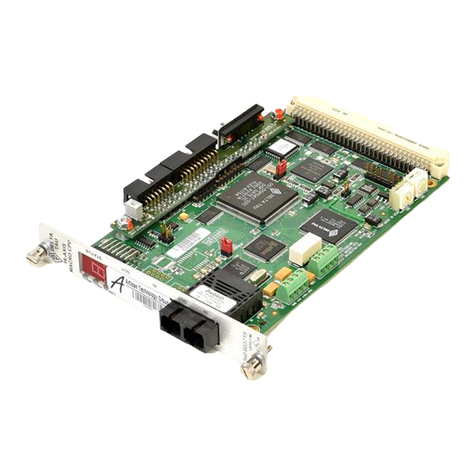
Delta Tau
Delta Tau 3U MACRO-CPU Board Quick user guide
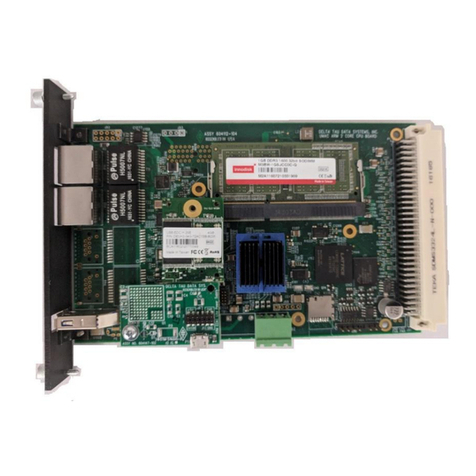
Delta Tau
Delta Tau 3-4112 Series Quick user guide

Delta Tau
Delta Tau PMAC2 VME Ultralite Quick user guide
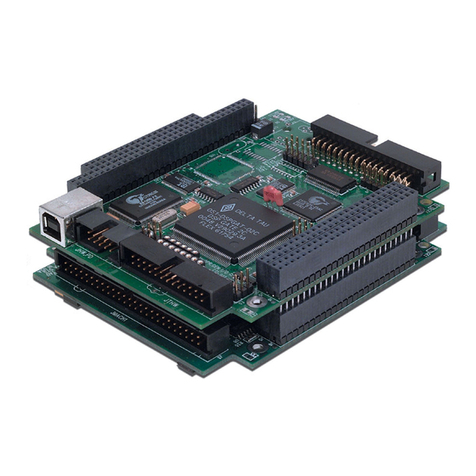
Delta Tau
Delta Tau PMAC2 PCI Quick user guide

Delta Tau
Delta Tau PMAC2-PC/104 User manual
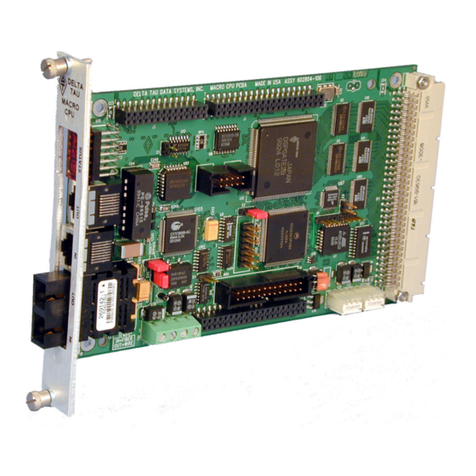
Delta Tau
Delta Tau MACRO CPU BOARD 4Ax-602804-xHxx Quick user guide
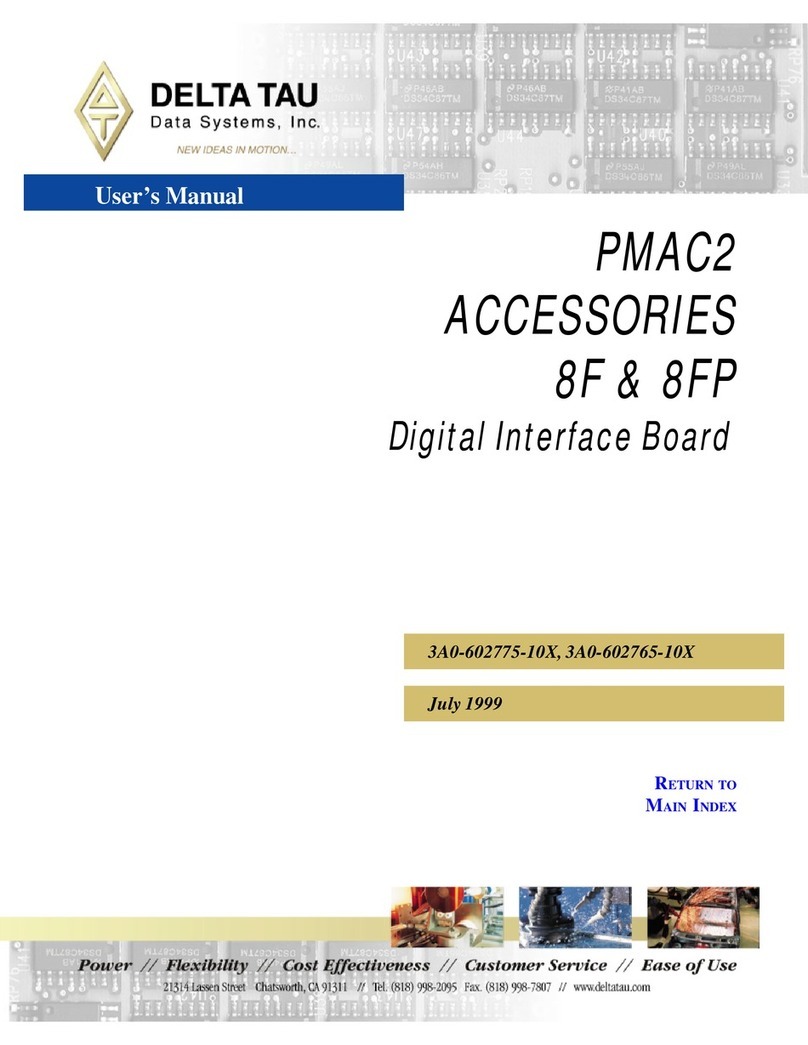
Delta Tau
Delta Tau 8F User manual

Delta Tau
Delta Tau 5XX-603869-XUXX Quick user guide

Delta Tau
Delta Tau PMAC2A-PC/104 Quick user guide

